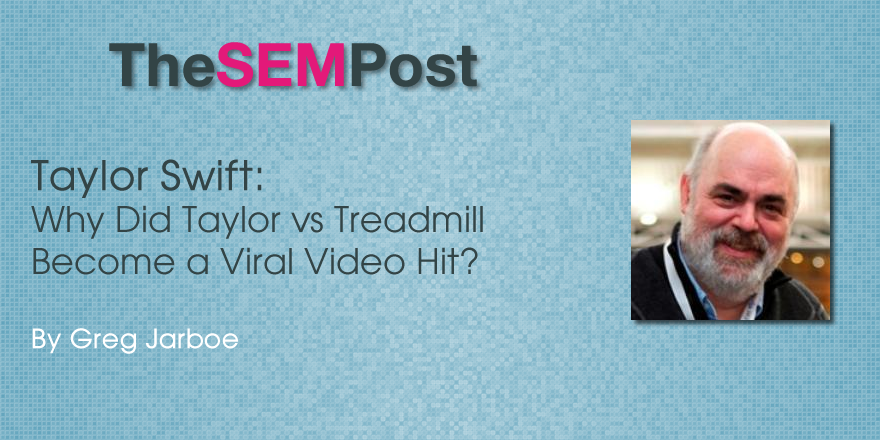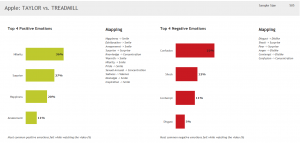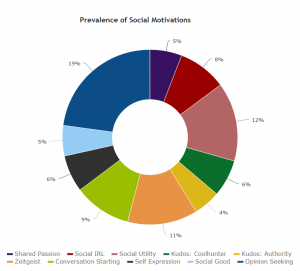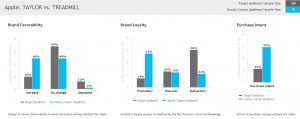 Most marketers would look at “TAYLOR vs. TREADMILL,” which was published to the Beats 1 Radio channel on YouTube back on April 1, 2016, and ask, “Was this just an April Fools’ Day joke or hoax?” All the video’s description says, “Distractingly good. Apple Music.” So, it’s hard to tell.
Most marketers would look at “TAYLOR vs. TREADMILL,” which was published to the Beats 1 Radio channel on YouTube back on April 1, 2016, and ask, “Was this just an April Fools’ Day joke or hoax?” All the video’s description says, “Distractingly good. Apple Music.” So, it’s hard to tell.
But, after I saw the video receive 16.9 million views in its first month, I asked the folks at Unruly, “Why did ‘TAYLOR vs. TREADMILL’ became a viral video hit?”
Now, how would they know the answer to my question? Well, back in March, the ad tech company launched a new dashboard called Unruly Pulse, which tracks emotions of specific videos and overall industry trends.
Unruly tested “TAYLOR vs. TREADMILL” and found the top emotions that viewers felt while watching the video were:
- Hilarity – 36%
- Surprise – 27%
- Happiness – 20%
- Amazement – 11%

Why is this important? Well, there are two reasons.
First, as Dr. Karen Nelson-Field, the Director of the Centre for Digital Video Intelligence, says in her book, Viral Marketing: The Science of Sharing, “Content that draws a high-arousal positive emotional response is shared more.” And “hilarity” is an example of a high-arousal emotion, while “amusement” is an example of a low-arousal emotion. So, even if you aren’t promoting Apple Music, it’s worth knowing that brands and agencies need to be extremely funny to impress consumers worn down by a glut of video ads which try to be funny (and usually are not).
Second, Dr. Nelson-Field adds, “On average, videos that elicit high-arousal emotions gain twice as much sharing as those that elicit low-arousal emotions; yet more than 70% of all commercial videos evoke low-arousal emotions.” So, it appears that the highest paid person’s opinion (HiPPO) of what’s funny is wrong more than twice as often as its right. Telling the highest paid person he or she is wrong can get you fired, but showing that person what viewers think of your video could make you a hero.
Now, if that was all that Unruly Pulse could tell us, then this would be a much shorter post. But wait, there’s more!
Unruly Pulse also shows us the most common reasons that viewers wanted to share the video. The top ones were:
- Opinion seeking – 19%
- Social utility – 12%
- Zeitgeist – 11%
- Conversation starting – 9%

Now, just because someone has watched your video doesn’t mean that they’ll share it. Why? Well Avinash Kaushik gave a great explanation recently in a post entitled, “How to Suck at Social Media: An Indispensable Guide for Businesses.” Before any viewer shares your post, video, tweet, or Pin, they ask themselves, “Is what you are saying so incredible and of value that I’ll stamp my brand on it and forward it to everyone I know?”
Okay, so viewers shared “TAYLOR vs. TREADMILL.” Is that a big deal? Are “shares” like free gifts, valuable coupons, and points earned towards unique rewards? Well, looking at “shares” instead of “views” has a lot of merit because research shows that social video recommendations significantly impact traditional brand metrics.
In fact, Unruly Pulse shows that the video increased brand favorability with 20% of the target audience, brand loyalty with 12%, and purchase intent with 22%. Now, that could help you pay the rent next month. But, here’s what could earn you your next promotion: Unruly Pulse identifies the segments that over-index for happiness and opinion seeking. And by using this data for targeting, “TAYLOR vs. TREADMILL” increased brand favorability with 49% of the Unruly Custom Audience, brand loyalty with 54%, and purchase intent with 58%.

In other words, Unruly Pulse can provide insight into the emotional trends of video advertising across sectors, specific brands, and major zeitgeist events. This means that brands and agencies can now understand their brand position relative to their category and competitors. This enables them to:
- Track how emotions resonate over time.
- Find out what motivates viewers to share a piece of content.
- Make data-driven decisions to drive brand metrics and purchase intent.
So, the highest paid person at brands can continue using his or her “gut” to decide how to create a viral video. Or, the highest paid person at agencies can continue to tell their clients that you can’t make videos go viral. Or, marketers can realize that there is a science of sharing – and read books or check out Unruly Pulse to learn how to master this social science.

Now, Unruly and Dr. Nelson-Field aren’t clients of my agency. I don’t have a material connection with them. Heck, I haven’t even received any swag from them. So, I have nothing to disclose. But, I am sharing this information about “TAYLOR vs. TREADMILL” with you for the same reason that people share posts, videos, tweets, and pins: Because I think that what Dr. Nelson-Field and Unruly are saying is so incredible and of value that I’ll stamp my brand on it and forward it to everyone I know.
Michael Schlager says
Although I only have 6 videos, I’m redoing them now. Very few could hit more than one or two reasons, but Greg, I think your work here touched on all of them. Excellent fuel for thought and action. Thank you.
Greg Jarboe says
Happy to help, Michael.